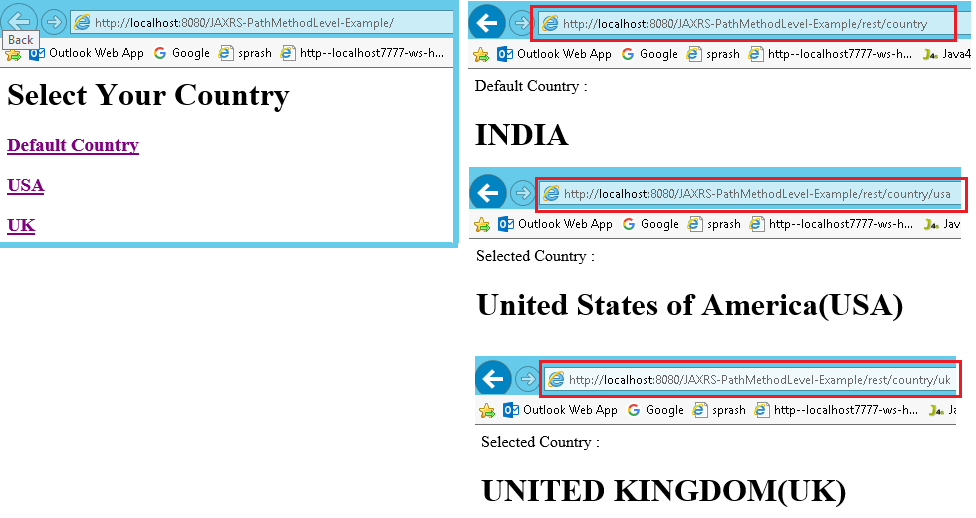JAX-RS @Path annotation
We can use @Path to bind URI pattern to a Java method
1.Create Dynamic web project in eclipse, convert that into Maven Project
2. Add Jersey jar files manually / through Maven by writing repo details in pom.xml
<project xmlns="http://maven.apache.org/POM/4.0.0" xmlns:xsi="http://www.w3.org/2001/XMLSchema-instance" xsi:schemaLocation="http://maven.apache.org/POM/4.0.0 http://maven.apache.org/xsd/maven-4.0.0.xsd">
<repositories>
<repository>
<id>maven2-repository.java.net</id>
<name>Java.net Repository for Maven</name>
<url>http://download.java.net/maven/2/</url>
<layout>default</layout>
</repository>
</repositories>
<dependencies>
<!-- https://mvnrepository.com/artifact/com.sun.jersey/jersey-server -->
<dependency>
<groupId>com.sun.jersey</groupId>
<artifactId>jersey-server</artifactId>
<version>1.19.3</version>
</dependency>
<!-- https://mvnrepository.com/artifact/org.glassfish.jersey.core/jersey-client -->
<dependency>
<groupId>org.glassfish.jersey.core</groupId>
<artifactId>jersey-client</artifactId>
<version>2.25</version>
</dependency>
<!-- https://mvnrepository.com/artifact/javax.ws.rs/javax.ws.rs-api -->
<dependency>
<groupId>javax.ws.rs</groupId>
<artifactId>javax.ws.rs-api</artifactId>
<version>2.0</version>
</dependency>
</dependencies>
</project>
3.Create RESTFul webservice
package service;
import javax.ws.rs.GET;
import javax.ws.rs.Path;
import javax.ws.rs.Produces;
import javax.ws.rs.core.Response;
@Path("/country")
public class PathMethodLevelService {
@GET
@Produces("text/html")
public Response selectCountry() {
String output = " Default Country : <h1>INDIA</h1>";
return Response.status(200).entity(output).build();
}
@GET
@Path("/usa")
@Produces("text/html")
public Response selectUSA() {
String output = "Selected Country : <h1>United States of America(USA)</h1>";
return Response.status(200).entity(output).build();
}
@GET
@Path("/uk")
@Produces("text/html")
public Response selectUK() {
String output = "Selected Country : <h1>UNITED KINGDOM(UK)</h1>";
return Response.status(200).entity(output).build();
}
}
4.Configure web.xml
<?xml version="1.0" encoding="UTF-8"?>
<web-app xmlns:xsi="http://www.w3.org/2001/XMLSchema-instance" xmlns="http://java.sun.com/xml/ns/j2ee" xmlns:web="http://xmlns.jcp.org/xml/ns/javaee" xsi:schemaLocation="http://java.sun.com/xml/ns/j2ee http://java.sun.com/xml/ns/j2ee/web-app_2_4.xsd" id="WebApp_ID" version="2.4">
<display-name>JAXRS-PathMethodLevel-Example</display-name>
<servlet>
<servlet-name>jersey-serlvet</servlet-name>
<servlet-class>com.sun.jersey.spi.container.servlet.ServletContainer</servlet-class>
<init-param>
<param-name>com.sun.jersey.config.property.packages</param-name>
<param-value>service</param-value>
</init-param>
<load-on-startup>1</load-on-startup>
</servlet>
<servlet-mapping>
<servlet-name>jersey-serlvet</servlet-name>
<url-pattern>/rest/*</url-pattern>
</servlet-mapping>
</web-app>
5. Test Webservice directly by using URL / writing webservice client
http://localhost:8080/JAXRS-PathMethodLevel-Example/ for Default country request
http://localhost:8080/JAXRS-PathMethodLevel-Example/rest/country/usa for usa
http://localhost:8080/JAXRS-PathMethodLevel-Example/rest/country/uk for UK

Response Class in JAX-RS
javax.ws.rs.core.Response class is reserved for an extension by a JAX-RS implementation providers. An application should use one of the static methods to create a Response instance using a ResponseBuilder. An application class should not extend this class directly
We have following methods in Responnse classs which are used majorly
-
public abstract int getStatus()
-
public abstract MultivaluedMap<String,Object> getMetadata()
-
public static ResponseBuilder status(Response.StatusType status)
-
public static Response.ResponseBuilder ok()